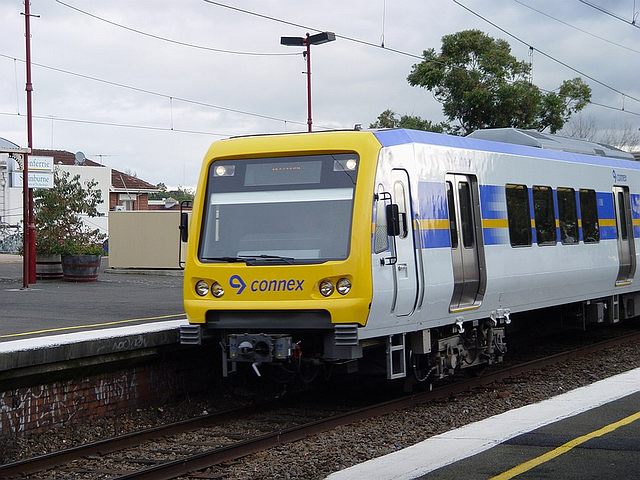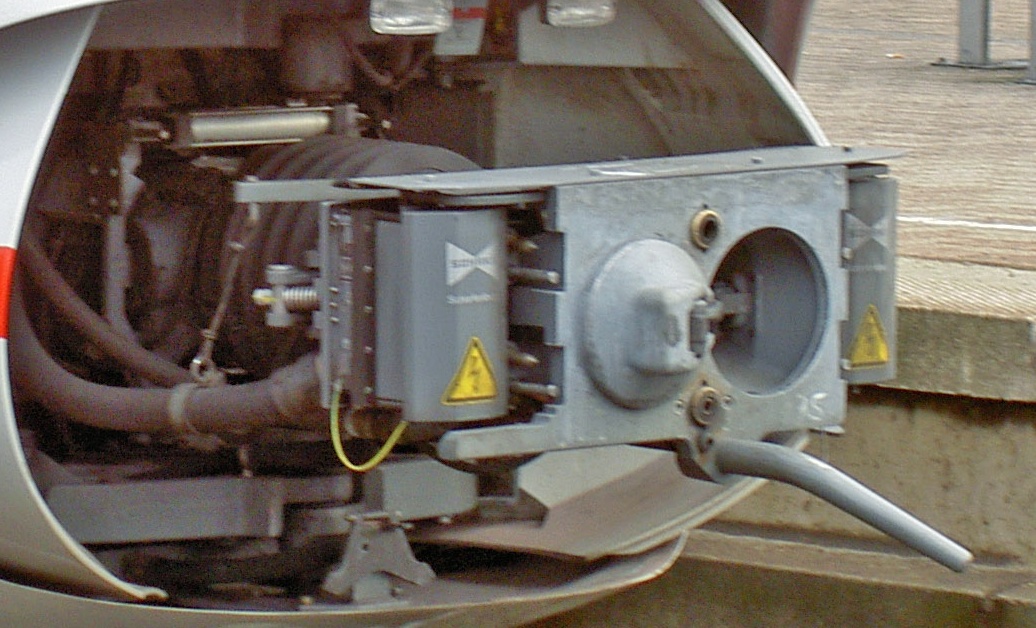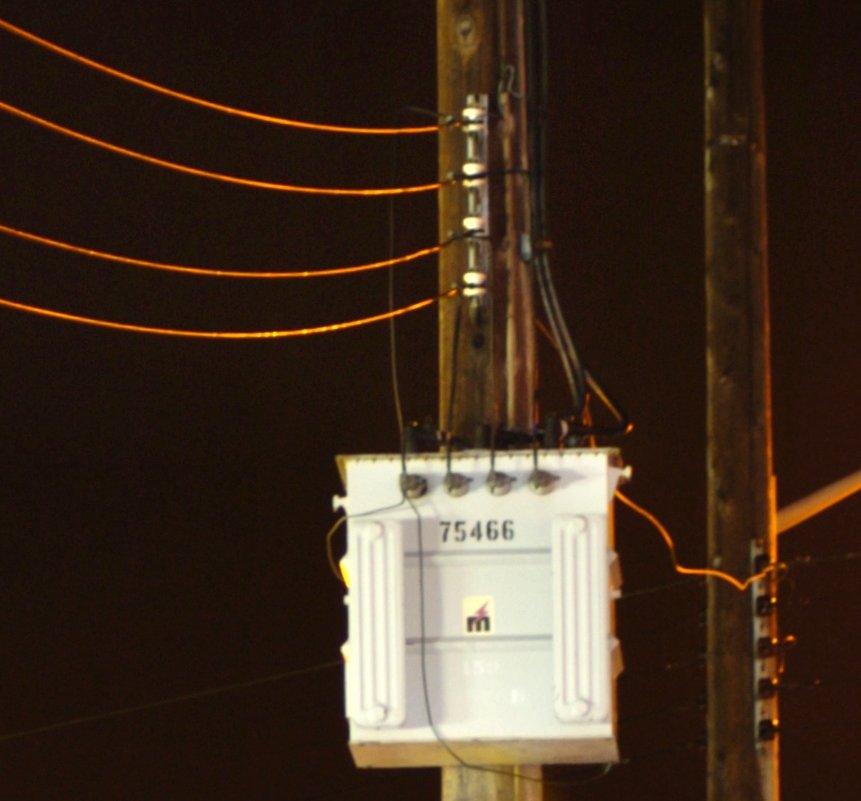|
X'Trapolis 100
The X'Trapolis 100 is a class of single deck electric multiple units part of Alstom's X'Trapolis family of trains, operated in Melbourne, Victoria, Australia and Valparaíso, Chile. Melbourne In service When originally introduced to the suburban network in 2002, the trains operated only on the former Hillside network (consisting of the Burnley and Clifton Hill group lines), and did not run revenue services elsewhere operated by M>Train on the Bayside Trains half of the system. Although the networks merged in 2004, when Connex took over all operations, the X'trapolis units did not operate on the Bayside system at the time. On 22 October 2014, the operation of X'Trapolis 100 trains was expanded to include lines on the former Bayside Trains network with the Frankston line being cleared for their operation and initially running two weekday morning-peak services. On 20 November 2016, X'Trapolis 100 trains were expanded to full-time running on the Frankston line and began op ... [...More Info...] [...Related Items...] OR: [Wikipedia] [Google] [Baidu] |
Electric Multiple Unit
An electric multiple unit or EMU is a multiple-unit train consisting of self-propelled carriages using electricity as the motive power. An EMU requires no separate locomotive, as electric traction motors are incorporated within one or a number of the carriages. An EMU is usually formed of two or more semi-permanently coupled carriages, but electrically powered single-unit railcars are also generally classed as EMUs. The great majority of EMUs are passenger trains, but versions also exist for carrying mail. EMUs are popular on commuter and suburban rail networks around the world due to their fast acceleration and pollution-free operation. Being quieter than diesel multiple units (DMUs) and locomotive-hauled trains, EMUs can operate later at night and more frequently without disturbing nearby residents. In addition, tunnel design for EMU trains is simpler as no provision is needed for exhausting fumes, although retrofitting existing limited-clearance tunnels to accommodate th ... [...More Info...] [...Related Items...] OR: [Wikipedia] [Google] [Baidu] |
Werribee Railway Line
The Werribee railway line is a commuter rail passenger train service in Melbourne, Australia, operating between Werribee in the western suburbs to Flinders Street in the central business district. The line traverses the flat plains of Melbourne's western suburbs, and after leaving Footscray, has no significant earthworks. The area around the outer end of the line has seen significant residential growth in recent years, resulting in strong patronage growth. It is part of the Melbourne metropolitan rail network operated by Metro Trains. Infrastructure The Werribee line consists of multiple tracks, shared with other lines, from the City Loop until South Kensington, after which it becomes double track. From Newport South Junction, which is about a kilometre after Newport, the two tracks are signalled for bi-directional operation, although it is very rare for trains to use the possibility of right-hand running. About one and a half kilometres from Newport South, the Altona ... [...More Info...] [...Related Items...] OR: [Wikipedia] [Google] [Baidu] |
Frankston Railway Line, Melbourne
The Frankston railway line is a 42.7 km commuter rail passenger train service in Melbourne, Victoria. It operates between Flinders Street in the Melbourne central business district and Frankston through the south-eastern suburbs including Richmond, South Yarra, Armadale, Malvern, Caulfield East, Glen Huntly, Ormond, McKinnon, Bentleigh, Moorabbin, Cheltenham, Mentone, Parkdale, Mordialloc, Aspendale, Edithvale, Chelsea, Bonbeach, Carrum, Seaford, and Frankston. The line continues on to Stony Point as the non-electrified Stony Point line from Frankston, however, there are no through services between Stony Point and the city. It is operated by Metro Trains Melbourne and is part of the Public Transport Victoria metropolitan rail network. Between Caulfield and the city, the Frankston line acts as a de facto local service whilst Pakenham/Cranbourne line trains run express. Description The Frankston line runs south from Caulfield, functioning from the main line to Pakenha ... [...More Info...] [...Related Items...] OR: [Wikipedia] [Google] [Baidu] |
M-Train
M-Train (stylised as M>Train) was a train operator in Melbourne, Australia, and operated some of the city's suburban rail operations. Formed in October 1997 as Bayside Trains, a business unit of the Public Transport Corporation, it was privatised in August 1999 becoming a subsidiary of National Express. In December 2002 National Express handed the franchise in, with the State Government taking over until negotiations were concluded for Connex Melbourne to take over in April 2004. History On 1 October 1997 in preparation for privatisation, the Public Transport Corporation's suburban rail operations were split into two business units, Bayside Trains and Hillside Trains. The former took over operation of the Frankston, Cranbourne, Pakenham, Sandringham, Williamstown, Werribee, Sydenham (now Sunbury), Broadmeadows (now Craigieburn) and Upfield line services. Bayside Trains initially operated service on the Orbost line as far as Warragul under contract to V/Line until ... [...More Info...] [...Related Items...] OR: [Wikipedia] [Google] [Baidu] |
Connex Melbourne
Connex Melbourne was a train operator in Melbourne, Australia. Formed in October 1997 as Hillside Trains, a business unit of the Public Transport Corporation, it was privatised in August 1999 becoming a subsidiary of Connex. In April 2004, it became the sole operator of Melbourne suburban rail services, taking over the services of M>Train. When the franchise was re-tendered, it was awarded to Metro Trains Melbourne from November 2009. History On 1 October 1997, in preparation for privatisation, the Public Transport Corporation's suburban rail operations were split into two business units, Bayside Trains and Hillside Trains. The latter took over operation of the Lilydale, Belgrave, Alamein, Glen Waverley, Epping (now Mernda) and Hurstbridge line services. Connex successfully bid to take over the Hillside Trains services from 29 August 1999 beating competition from GB Railways and National Express. It was rebranded Hillside Trains as Connex Melbourne in July 2000."Conn ... [...More Info...] [...Related Items...] OR: [Wikipedia] [Google] [Baidu] |
Scharfenberg Coupler
The Scharfenberg coupler (german: Scharfenbergkupplung, abbreviated ''Schaku'') is a commonly used type of fully automatic railway coupling. Designed in 1903 by Karl Scharfenberg in Königsberg, Germany (today Kaliningrad, Russia), the coupler has gradually spread from transit trains to regular passenger service trains, although outside Europe its use is generally restricted to mass transit systems. The ''Schaku'' is superior in many ways to the AAR (Janney/knuckle) coupler because it also automates electrical and pneumatic connections and disconnections. However, there is no standard for the placement of these electro-pneumatic connections. Some rail operators have placed them on the sides while others have placed them either below or above the mechanical portion of the coupler. . Working principles The face of the Scharfenberg coupler has a protruding cone and a matching cup. Inside the cone there is a rigid metal hoop connected to a revolving, spring-loaded metal disk with a ... [...More Info...] [...Related Items...] OR: [Wikipedia] [Google] [Baidu] |
Pantograph (transport)
A pantograph (or "pan" or "panto") is an apparatus mounted on the roof of an electric train, tram or electric bus to collect power through contact with an overhead line. By contrast, battery electric buses and trains are charged at charging stations. The pantograph is a common type of current collector; typically, a single or double wire is used, with the return current running through the rails. The term stems from the resemblance of some styles to the mechanical pantographs used for copying handwriting and drawings. Invention The pantograph, with a low-friction, replaceable graphite contact strip or "shoe" to minimise lateral stress on the contact wire, first appeared in the late 19th century. Early versions include the bow collector, invented in 1889 by Walter Reichel, chief engineer at Siemens & Halske in Germany, and a flat slide-pantograph first used in 1895 by the Baltimore and Ohio Railroad The familiar diamond-shaped roller pantograph was devised and patente ... [...More Info...] [...Related Items...] OR: [Wikipedia] [Google] [Baidu] |
Overhead Line
An overhead line or overhead wire is an electrical cable that is used to transmit electrical energy to electric locomotives, trolleybuses or trams. It is known variously as: * Overhead catenary * Overhead contact system (OCS) * Overhead equipment (OHE) * Overhead line equipment (OLE or OHLE) * Overhead lines (OHL) * Overhead wiring (OHW) * Traction wire * Trolley wire This article follows the International Union of Railways in using the generic term ''overhead line''. An overhead line consists of one or more wires (or rails, particularly in tunnels) situated over rail tracks, raised to a high electrical potential by connection to feeder stations at regular intervals. The feeder stations are usually fed from a high-voltage electrical grid. Overview Electric trains that collect their current from overhead lines use a device such as a pantograph, bow collector or trolley pole. It presses against the underside of the lowest overhead wire, the contact wire. Current colle ... [...More Info...] [...Related Items...] OR: [Wikipedia] [Google] [Baidu] |
Induction Motor
An induction motor or asynchronous motor is an AC electric motor in which the electric current in the rotor needed to produce torque is obtained by electromagnetic induction from the magnetic field of the stator winding. An induction motor can therefore be made without electrical connections to the rotor. An induction motor's rotor can be either wound type or squirrel-cage type. Three-phase squirrel-cage induction motors are widely used as industrial drives because they are self-starting, reliable and economical. Single-phase induction motors are used extensively for smaller loads, such as household appliances like fans. Although traditionally used in fixed-speed service, induction motors are increasingly being used with variable-frequency drives (VFD) in variable-speed service. VFDs offer especially important energy savings opportunities for existing and prospective induction motors in variable-torque centrifugal fan, pump and compressor load applications. Squirrel-ca ... [...More Info...] [...Related Items...] OR: [Wikipedia] [Google] [Baidu] |
Three-phase Electric Power
Three-phase electric power (abbreviated 3φ) is a common type of alternating current used in electricity generation, transmission, and distribution. It is a type of polyphase system employing three wires (or four including an optional neutral return wire) and is the most common method used by electrical grids worldwide to transfer power. Three-phase electrical power was developed in the 1880s by multiple people. Three-phase power works by the voltage and currents being 120 degrees out of phase on the three wires. As an AC system it allows the voltages to be easily stepped up using transformers to high voltage for transmission, and back down for distribution, giving high efficiency. A three-wire three-phase circuit is usually more economical than an equivalent two-wire single-phase circuit at the same line to ground voltage because it uses less conductor material to transmit a given amount of electrical power. Three-phase power is mainly used directly to power large inducti ... [...More Info...] [...Related Items...] OR: [Wikipedia] [Google] [Baidu] |
Variable-frequency Drive
A variable-frequency drive (VFD) is a type of motor drive used in electro-mechanical drive systems to control AC motor speed and torque by varying motor input frequency and, depending on topology, to control associated voltage or current variation., quote is per definition on p. 4 of NEMA Standards Publication ICS 7.2-2021. VFDs may also be known as 'AFDs' (adjustable-frequency drives), 'ASDs' (adjustable-speed drives), 'VSDs' (variable-speed drives), 'AC drives', 'micro drives', 'inverter drives' or, simply, 'drives'. VFDs are used in applications ranging from small appliances to large compressors. An increasing number of end users are showing greater interest in electric drive systems due to more stringent emission standards and demand for increased reliability and better availability. Systems using VFDs can be more efficient than those using throttling control of fluid flow, such as in systems with pumps and damper control for fans. However, the global market pene ... [...More Info...] [...Related Items...] OR: [Wikipedia] [Google] [Baidu] |








.jpg)


